Hello, advertisers!
HilltopAds team welcomes you on another in-depth research for better understanding of ad campaign targetings.
Last time, we shared a distribution of ad blockers among different browsers and regions (make sure you check it out, because it makes a great combo together with this article).
Introduction: The Point of the Research
In the world of digital advertising, knowing your audience is only half the battle. Equally essential is understanding how and where you can access clients.
When it comes to browser preferences, every country has its quirks. While Chrome and Safari lead globally, the finer details reveal unique user choices in different regions that can shape ad targeting strategies.
This new research on browser popularity by region reveal insights that will enhance the effectiveness of your targeting strategy. We collected data about the most widely used browsers in each region, uncovering unique patterns that reflect both user habits and technology access. For instance, some regions lean heavily on mobile browsers, while others display a strong preference for desktop alternatives. By tapping into these trends, advertisers can craft region-specific campaigns that align with local browsing habits, maximizing ad reach, visibility, and user engagement.
Jump on board and let’s dive right into it!
The Big Picture: Traffic Distribution among Browsers Worldwide
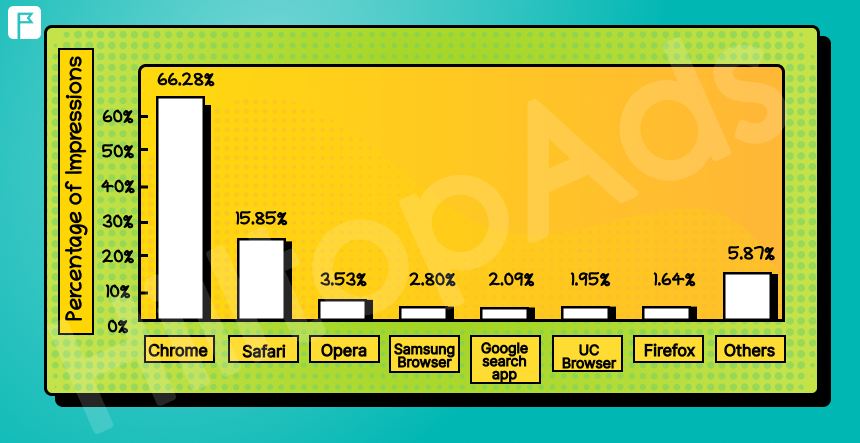
As it could be expected, Chrome and Safari dominate the world market, with Chrome holding around 66% of global traffic and Safari securing 15% share. A collective 13% goes to the group of less popular browsers, such as: Opera, Samsung Browser, Google Search, UC Browser, and Firefox. And the remaining 6% belongs to even lesser-known browsers.
This overview was just the tip of the iceberg. Further, you’ll see that segmenting each browser by mobile and desktop devices, the popularity by country highly varies even within a single region.
Chrome’s Popularity: Region by Region
Mobile Devices: Chrome’s Hot Spots
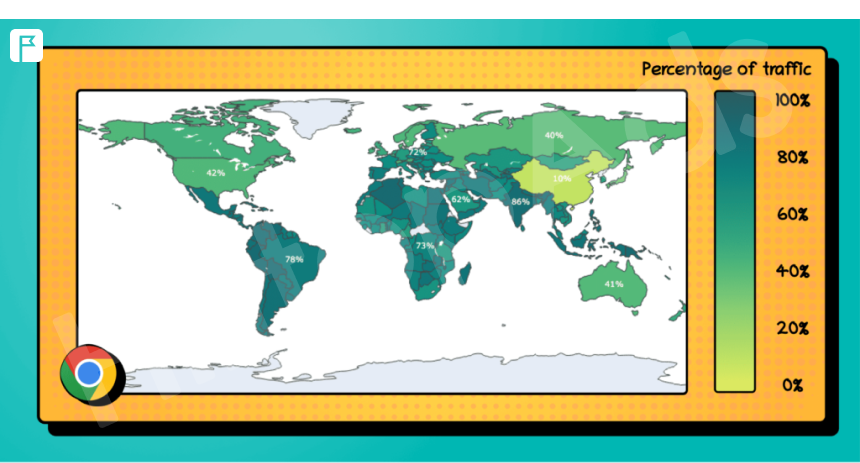
Chrome Mobile is on top of its popularity in South America, Africa, and large parts of Asia and Europe.
On the other hand, Chrome Mobile is not used that common in places like North America, Australia, Northern Europe, Japan, and Russia. There Chrome’s dominance dips below 50%.
Finally, there’s China, where Chrome is officially blocked.
Interestingly, we registered 10% Chrome usage in China. It can be explained by the fact, that local browsers adopt Chrome’s user agent string, tricking some data tools into counting it as Chrome traffic.
Desktop Use: Same Hero, Different Story

On desktops, Chrome’s usage rate varies more than on mobile. It remains the top pick in Asia and South America, though its traffic share here is 10-15% lower compared to mobile.
In Europe, Chrome’s desktop popularity dips even further, especially in GEOs like Germany, Austria, and Switzerland.
Meanwhile, Chrome doesn’t register much on desktops in most African countries and some Asian and South American nations.
China stands out again, as local browsers using Chrome’s user agent (like 360 Browser) have a higher share on desktops than on mobile.
Safari’s Popularity: Region by Region
Even though Safari occupies much less of traffic worldwide compare to Google’s browser (15% vs 66%, see the statistics in Section 1.), there are certain regions, where it managed to overplay Chrome.
In fact, Safari’s success often correlates with regions where Chrome is less popular.
Let’s find out more about both Mobile and Desktop shares.
Mobile Safari
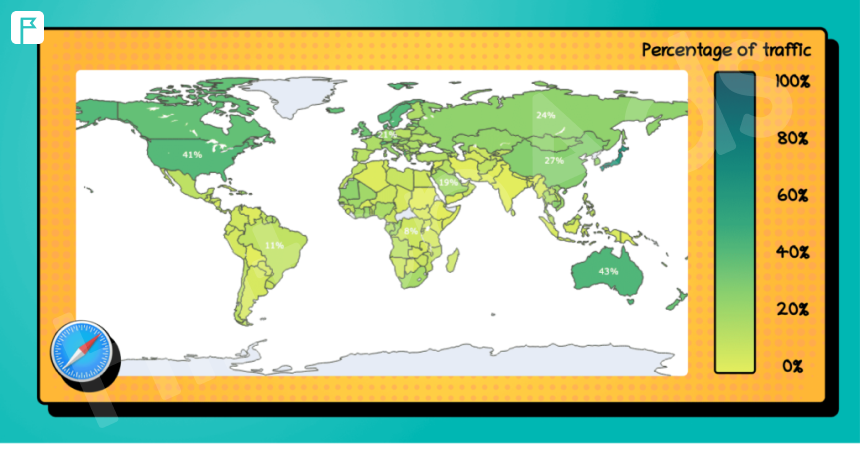
Safari Mobile dominates in the United States, Canada, Australia, Japan, and Northern Europe (especially in Norway and Sweden) markets. These are regions where Chrome usage is notably less prevalent, giving Safari a stronger foothold among mobile users.
Desktop Safari
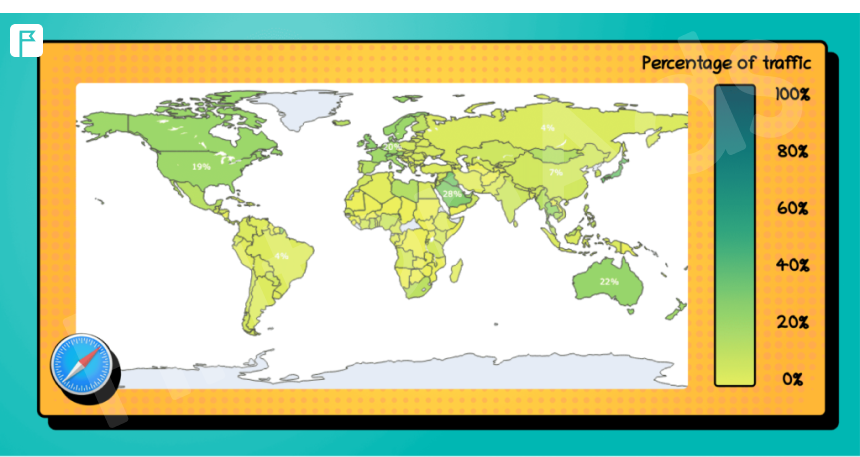
Similarly, Safari’s desktop presence mirrors its mobile dominance.
However, a unique trend is observed in Saudi Arabia and Iraq, where Safari’s desktop version has a particularly high user share, setting these regions apart from others in terms of desktop browser preference.
Finalizing Thoughts about Chrome’s and Safari’s Users
In regions like India, the United States, Germany, and Japan, a high diversity of desktop browsers exists, with Chrome and Safari collectively capturing less than the expected 80% of the desktop market. This suggests greater competition between browsers on desktop devices compared to mobile, where fewer players hold the highest shares. Therefore, we decided to investigate the less known browsers in more details to find the answers to the questions: In which regions have these browsers gained popularity? What are the top regions for each of them? And does the situation differ between the mobile and desktop versions?
Traffic Distribution between Other Browsers by Countries
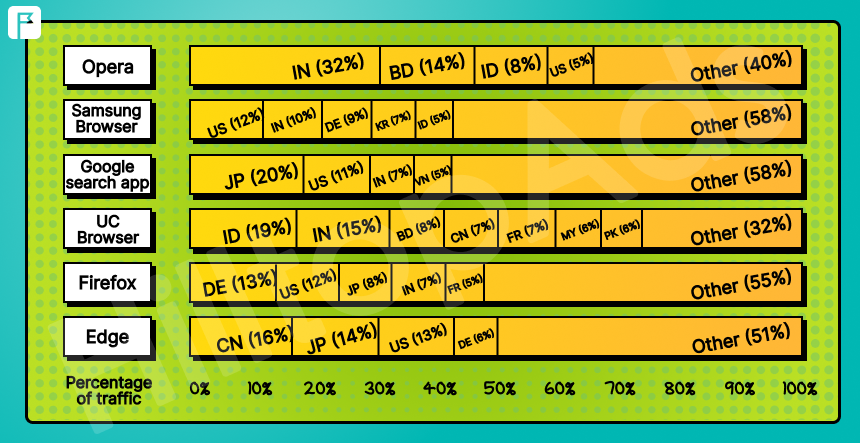
Surprisingly, there is a number of other browsers beside Chrome and Safari, which can claim their corner of the market.
- Opera shines in South and Southeast Asia, including India, Bangladesh, and Indonesia.
- Samsung Browser has a stronghold in various individual countries rather than an entire region, including the U.S., India, Germany, South Korea, and Indonesia.
- Google Search App usage spikes in Japan and is also popular in India, the U.S., and Vietnam.
- UC Browser thrives in South, East, and Southeast Asia—from Indonesia to India, China, and Bangladesh, with an outlier in France, where it holds 8% of traffic.
- Firefox enjoys popularity in Germany, the U.S., Japan, India, and France.
- Edge gains traction in the U.S., Japan, India, and Germany, though in China, as with Chrome, local browsers often emulate its user agent.
Countries like India, the U.S., Germany, and Japan are hotspots for browser diversity.
Unpopular Browsers, that Found their Audience in Certain Regions

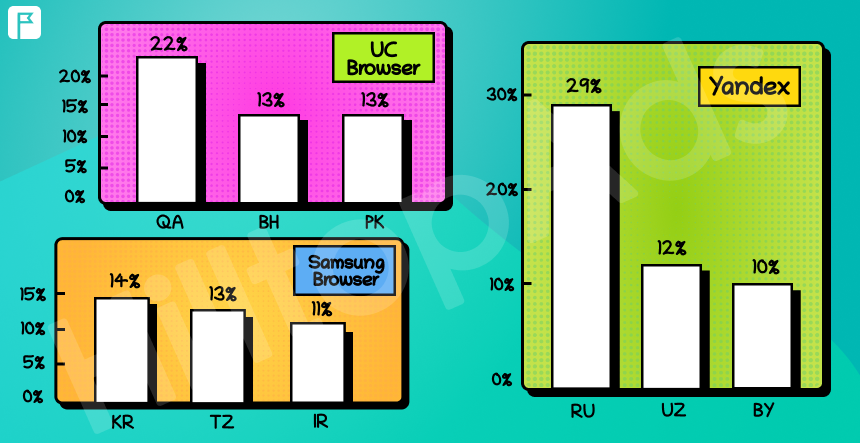
Certain countries have embraced browsers that are otherwise minor players globally, giving advertisers valuable insight into local preferences:
- Baidu App dominates in China with a solid 14% share.
- Firefox holds 10% of the market in Luxembourg.
- Google Search App leads with 15% in Laos.
- Opera is the top choice in Bangladesh (22%), with significant shares (around 14-15%) in Somalia, Libya, Tanzania, Kuwait, Pakistan, and Cameroon.
- Samsung Browser is widely used in South Korea (14%), Tanzania (13%), and Iran (11%).
- UC Browser captures 22% in Qatar and holds 13% for both Bahrain and Pakistan.
- Yandex naturally leads in Russia (28%), with strong showings in Uzbekistan (12%) and Belarus (10%).
Key Insights for Marketers and Advertisers
Congratulations! Now, you can set up targeting that based not only on your theories, but also on a solid statistics provided by HilltopAds team.
Understanding browser preferences by region is essential for effective ad targeting, especially on desktop devices where competition among browsers is fiercer than on mobile. This diversity highlights opportunities for marketers to target users through browsers that are dominant in specific regions, rather than sticking solely to Chrome and Safari.
Browser insights like these can help tailor ad creatives, placements, and strategies to meet the preferences of each market. For advertisers and affiliate marketers, this nuanced understanding of browser trends can mean the difference between good and great campaign performance, especially when targeting countries with unique browser loyalties.
While Chrome and Safari dominate globally, there’s a world of opportunity within niche browser preferences, each offering a unique pathway to reach target audiences across the globe.
Ready to put your new knowledge into practice? Click the link to create an ad campaign with HilltopAds!



















